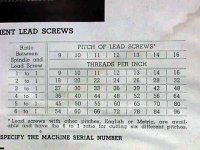Jarrod
Aluminum
- Joined
- Jul 18, 2011
- Location
- Toronto, ON
Hi all. I figure I should ask before I take a hammer to it...
I'm throwing around the idea of replacing the spindle entirely with a custom spindle to accept 2J collets. I have a pile of 2J collets and think the extra size would do me well and it's a reasonably complicated project to add to my list of things to do.
I just want to sort out what I'm working with... all the posts I've seen and read so far the spindle's outboard end does not have the features that mine has, so removal may be a bit different in my case. I can't actually get to the rear headstock cover plate, because all this crap is in the way.
Photos to come... there are no options to add photos at the moment...
I have what appears to be a indexing ring, but the machine did not come with any additional auxiliary equipment for using it.
I can see that the locating ring stops short in the spindle, which suggests it is a separate piece, but does it screw on left or right?
I don't see any set screw holes anywhere, so I am a bit puzzled how to attack this one.
I understand I will probably destroy the existing bearings, but the spindle nose needs to be reground one way or another, so it's a risk I'm willing to take.
Thanks,
Jarrod
I'm throwing around the idea of replacing the spindle entirely with a custom spindle to accept 2J collets. I have a pile of 2J collets and think the extra size would do me well and it's a reasonably complicated project to add to my list of things to do.
I just want to sort out what I'm working with... all the posts I've seen and read so far the spindle's outboard end does not have the features that mine has, so removal may be a bit different in my case. I can't actually get to the rear headstock cover plate, because all this crap is in the way.
Photos to come... there are no options to add photos at the moment...
I have what appears to be a indexing ring, but the machine did not come with any additional auxiliary equipment for using it.
I can see that the locating ring stops short in the spindle, which suggests it is a separate piece, but does it screw on left or right?
I don't see any set screw holes anywhere, so I am a bit puzzled how to attack this one.
I understand I will probably destroy the existing bearings, but the spindle nose needs to be reground one way or another, so it's a risk I'm willing to take.
Thanks,
Jarrod







 Plus the video shows a thread chasing attachment in action even if it's not exactly the one we're talking about.
Plus the video shows a thread chasing attachment in action even if it's not exactly the one we're talking about.